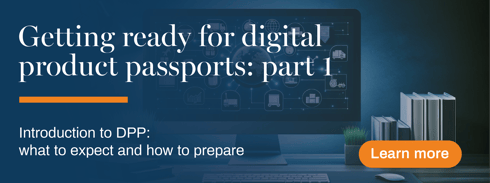In the second part of our digital product passport (DPP) blog series, we discuss how businesses can evaluate available technologies, ready themselves for DPPs, and take concrete steps towards implementation. Missed part one? Catch up by clicking here.
How can businesses implement DPP?
Digital product passports present a unique opportunity to provide consumers with more transparency and detailed insights into the products they purchase. However, the path to implementing DPPs comes with its set of challenges, ranging from technological infrastructure to data gaps in the supply chain. In this blog, our experts provide insights into some of the strategies businesses can adopt to prepare for the upcoming legislation.
Get your data in order
In many instances, companies currently lack the necessary data infrastructure for digital product passport data. Fortunately, emerging blockchain technologies offer solutions, facilitating secure data transfer on a large scale with significantly reduced energy consumption and operational costs.
“Data is scattered across various locations within an organization. It's highly unlikely that a company will have all its data in one place,” explains Helene Behrenfeldt, Industry & Solution Strategy Director – Fashion at Infor. “Integration is, therefore, crucial for collecting the necessary data for compliance reporting. Blockchain will be a hot topic because it offers an efficient way to collect this data across the supply chain.”
The upcoming EU legislation will define the minimum data required, but to make the most of the advantages, you should start to identify which data is essential, necessary, and falls into the nice-to-have category for your communication in the digital product passport.
However, while blockchain technology presents promising solutions to certain data challenges, we recognize it may not be a one-size-fits-all answer for every business. Preparing your data is more easily said than done, especially given the associated risks of importing data from legacy systems. It’s important to create a robust data strategy so you can achieve your business goals.
First steps towards that could be to answer key questions, such as what data is required to address your goals, who in the company uses it and responsible for it, and what is the current process of collecting this data. Subsequently, you should pay close attention to critical details, including data cleansing, de-duplication, compliance, identification of potential omissions in the data, and mapping the data alongside your data analysis techniques to align with new processes.
Evaluate your current systems
Digital product passports require new integrations and updated compliance. Espen Enger, Business Line Director in Columbus Norway, suggests leveraging cloud platforms like Infor CloudSuite and Microsoft Dynamics 365 to streamline data collection throughout the product lifecycle. These platforms offer comprehensive features, such as core ERP functionalities, ensuring you can meet changing industry standards and regulatory requirements.
Helene Behrenfeldt agrees: “The Infor CloudSuite for Fashion, as an example, includes applications like M3, which serves as a core ERP, alongside PLM (Product Lifecycle Management) and Nexus, among others. Additionally, we offer Infor OS, an operating service featuring a data lake designed to connect with various tools through ION integration. The initial phase of this process revolves around PLM, with a focus on design for disassembly—a concept that involves designing products with recycling or reuse in mind, taking into account factors such as composition.”
Helene also highlights CloudSuite Fashion’s integration with tools like Made2Flow, automating the essential data flow and impact calculations. By capturing data across the entire supply chain—from yarn suppliers and fabric companies to garment producers—Infor’s interface with Made2Flow enables meaningful real-time insights.
With this functionality, you can actively monitor, measure, and analyze crucial, predefined metrics. This not only boosts your visibility into the broader context of the fashion lifecycle but also enables essential collaboration for ongoing measurement to achieve your goals and communicate effectively with stakeholders. “This tool, with its unique machine learning algorithm, fills the data gaps and returns the refined data to us,” adds Helene.
Esben also mentions Columbus' partnership with GS1 Norway, a not-for-profit organization developing open standards across industries. GS1 standards provide a common language for over 58,000 organizations, promoting unique identification, description, and tracking.
"The importance of RFID technology for sustainability cannot be overstated. We have plans to facilitate a training course at GS1 Norway for one of our valued fashion industry customers in Scandinavia," says Esben. GS1 recently hosted an engaging digital product passport event as part of Oslo Innovation Week. Watch the highlights by clicking here.

Engage your stakeholders
Making sure your teams are ready for the changes that implementing DPP will bring should be a top priority, as it will significantly impact various parts of your organization. Businesses often overlook this aspect.
Instead of prioritizing people, the organization tends to focus too much on the solution or software, leading to a failure to deliver the expected benefits or value. However, the problem doesn't lie in the change itself but in how that change is managed.
To successfully implement digital product passports, an effective change management program is essential. This program ensures that your people stay engaged before, during, and after the implementation of new processes.
Effective change management not only enhances the chances of project success but can also contribute to improved return on investment (ROI). For instance, aligning the mindsets of key stakeholders can ensure broader team engagement with the change, and deliverables can progress and be completed on time and within budget.
Initiating change on your own can be overwhelming. We recommend establishing a business change management team, which you can resource with internal employees (seconded or internally developed), recruit externally, or outsource entirely.
We also advise resourcing your change management team internally because people are more likely to listen to and accept changes from colleagues rather than contractors. Whichever approach you choose, do this as soon as possible so your team can begin planning, engaging, and assessing the impact of DPP on the business processes.
Best practices to implementing digital product passports
While many businesses are just starting to explore digital product passports, some have made significant progress. Magnus Nikkarinen, Senior Policy Director – Sustainability at Swedish Commerce, explains his role in a Swedish Commerce project called 'ProPare’: “We collaborated with GS1 Sweden and the Nordic Ecolabel – The Swan to demonstrate the practical application of a digital product passport.
“Working alongside three of our member companies—one in food retail wholesale, another in interior construction, and the third in furniture retail—we sought to ensure compliance with legislative parameters. This involved securing a unique identification number and integrating a QR code specific to each product. Customers could easily retrieve information by scanning the QR code.”
“Our emphasis was on validating the Swan labeling present on products from these companies. To achieve this, we employed a decentralized system, enabling direct access to information from the Swan's data system. This approach was instrumental in confirming the legitimacy of products through third-party verification.”
Magnus also mentions an initiative involving Marimekko, a Finnish lifestyle design company renowned for its distinctive prints and colours. According to Magnus, they are collaborating on a project integrating QR codes with their products. The primary objective is to determine the essential data attributes crucial for the project's success. It goes beyond sustainability; emphasizing the digital product passport aspect is vital.
Marjut Lovi, Sustainability Manager at Marimekko, said to Trace4Value ahead of the program: “Digital product passports aim to increase transparency and traceability of products to enable improved consumer communications. This pilot program will help the industry to prepare for planned regulations that will move us one step closer to a circular economy.”
You can read more about the project by clicking here.
What will the future of digital product passports look like?
Julia Rochelli, Sales Manager at Columbus Sweden, raises an interesting question regarding these regulations: could factories shift back from Asia to Europe as it becomes easier to manufacture from here?
Magnus Nikkarinen responds: 'Yes, that was a question one of our company members received recently. It's not that simple, especially when it comes to information and data. Working with established Asian companies, they are highly digital and efficient. Moving operations back to Europe might not be as straightforward, as smaller European producers may struggle to provide the same level of data and information, particularly in industries like textiles. So the shift from Asia to Europe isn't likely in the foreseeable future due to the efficiency of operations in Asia.”
Julia provides her perspective on the current state of overproduction and suggests a solution that involves reversing the buying cycle. In her vision, traditional stores transform into showrooms, where customers pay a premium for immediate items or can place a special order after trying on the clothes. This model aims to minimize waste by shifting away from mass-produced items toward a more personalized and deliberate purchase process.
Helene Behrenfeldt, Industry & Solution Strategy Director – Fashion at Infor, proposes an idea which goes one step further: an online collection where products aren't sold. Customers can virtually try on clothing, capturing images as if in real life, creating a fictional experience. While Helene admits it’s a radical concept, this approach aligns with the growing sustainability movement, promoting the reuse and resale of products rather than continuous production.
Regardless of future developments, it’s clear that digital product passports will redefine how product information is managed and shared, benefitting both consumers and businesses alike. This transformation is a critical step towards sustainability, contributing to the reduction of plastic pollution and improving the tracking of environmental impact throughout a product's lifecycle. As businesses gain clearer guidelines and regulations from the EU commission, the creation of a standardized system that is accurate, reliable, and effective will become more straightforward.
Getting set for digital product passports
With new legislation on the horizon, now is the perfect time to get started with digital product passports. Implementing these changes will take time, so it’s important you kick off the process as soon as possible.
We can help you prepare for the future, plan the strategy and the roadmap towards DPP and choose the right solutions for your business. We’re also experts in change management and helping businesses ready their organizations for transformation. Together, we can ensure your team fully embraces the vision, maximizing the value and benefits from any change you make in preparation for digital product passports. Contact us by filling in the form below.
If you missed the first blog of this series, here is the link.

